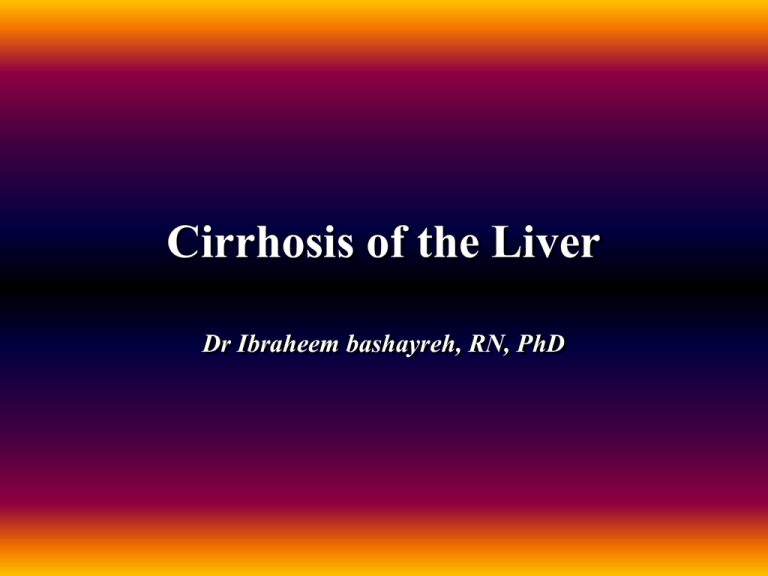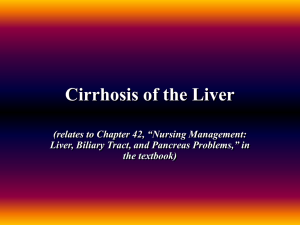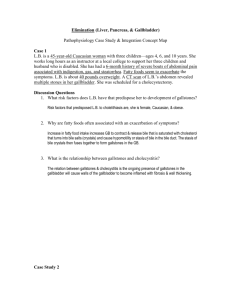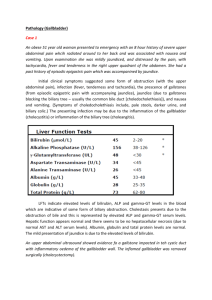Cirrhosis and Liver Failure
advertisement

Cirrhosis of the Liver Dr Ibraheem bashayreh, RN, PhD ANATOMY & PHYSIOLOGY LIVER a. Weighing between 1,200 and 1,600 g, the liver is the largest glandular organ in the body. It is located in the right upper abdominal quadrant, under the right diaphragm. b. The liver is divided into four lobes: left, right, caudate and quadrate. The lobes are further subdivided into smaller units known as lobules. c. The liver contains several cell types including hepatocytes (ie. Liver cells) and Kupffer cells (i.e. phagocytic cells that engulf bacteria). d. Bile is continuously formed by hepatocytes (about 1L/day). Bile comprises water, electrolytes , lecithin,fatty acids, cholesterol, bilirubin and bile salts. e. The Liver is surrounded by a tough fibroelastic capsule called Glisson’s capsule. FUNCTIONS OF THE LIVER • Regulating blood glucose level by making glycogen, which is stored in hepatocytes. • Synthesizing blood glucose from amino acids of lactate through gluconeogenesis. • Converting ammonia produced from gluconeogenetic by-products and bacteria to urea • Synthesizing plasma proteins such as albumin, globulins, clotting factors, and lipoproteins. • Breaking down fatty acids into ketone bodies • Storing vitamins and trace metals • Affecting drug metabolism and detoxification • Secreting bile Liver cirrhosis Description • A chronic, progressive disease of the liver – Extensive parenchymal cell degeneration – Destruction of parenchymal cells Description • Regenerative process is disorganized, resulting in abnormal blood vessel and bile duct relationships from fibrosis Description • Normal lobular structure distorted by fibrotic connective tissue • Lobules are irregular in size and shape with impaired vascular flow • Insidious, prolonged course Etiology and Pathophysiology • Cell necrosis occurs • Destroyed liver cells are replaced by scar tissue • Normal architecture becomes nodular Etiology and Pathophysiology • Four types of cirrhosis: – Alcoholic (Laennec’s) cirrhosis – Postnecrotic cirrhosis – Biliary cirrhosis – Cardiac cirrhosis Etiology and Pathophysiology • Alcoholic (Laennec’s) Cirrhosis – Associated with alcohol abuse – Preceded by a theoretically reversible fatty infiltration of the liver cells – Widespread scar formation Etiology and Pathophysiology • Postnecrotic Cirrhosis – Complication of toxic or viral hepatitis – Accounts for 20% of the cases of cirrhosis – Broad bands of scar tissue form within the liver Etiology and Pathophysiology • Biliary Cirrhosis – Associated with chronic biliary obstruction and infection – Accounts for 15% of all cases of cirrhosis Etiology and Pathophysiology • Cardiac Cirrhosis – Results from longstanding severe rightsided heart failure Manifestations of Liver Cirrhosis Fig. 42-5 Clinical Manifestations Early Manifestations • Onset usually insidious • GI disturbances: – Anorexia – Dyspepsia – Flatulence – N-V, change in bowel habits Clinical Manifestations Early Manifestations • • • • • Abdominal pain Fever Lassitude (laziness) Weight loss Enlarged liver or spleen Clinical Manifestations Late Manifestations • Two causative mechanisms – Hepatocellular failure – Portal hypertension Clinical Manifestations Jaundice • Occurs because of insufficient conjugation of bilirubin by the liver cells, and local obstruction of biliary ducts by scarring and regenerating tissue Clinical Manifestations Jaundice • Intermittent jaundice is characteristic of biliary cirrhosis • Late stages of cirrhosis the patient will usually be jaundiced Clinical Manifestations Skin • Spider angiomas (telangiectasia, spider nevi) • Palmar erythema Clinical Manifestations Endocrine Disturbances • Steroid hormones of the adrenal cortex (aldosterone), testes, and ovaries are metabolized and inactivated by the normal liver Clinical Manifestations Endocrine Disturbances • Alteration in hair distribution – Decreased amount of pubic hair – Axillary and pectoral alopecia Clinical Manifestations Hematologic Disorders • Bleeding tendencies as a result of decreased production of hepatic clotting factors (II, VII, IX, and X) Clinical Manifestations Hematologic Disorders • Anemia, leukopenia, and thrombocytopenia are believed to be result of hypersplenism Clinical Manifestations Peripheral Neuropathy • Dietary deficiencies of thiamine, folic acid, and vitamin B12 Complications • • • • Portal hypertension and esophageal varices Peripheral edema and ascites Hepatic encephalopathy Fetor hepaticus: is bad breath with a 'dead mouse' or sweet faecal smell. ... It may be caused by severe hepatocellular damage Complications Portal Hypertension • Characterized by: – Increased venous pressure in portal circulation – Splenomegaly – Esophageal varices – Systemic hypertension Complications Portal Hypertension • Primary mechanism is the increased resistance to blood flow through the liver Complications Portal Hypertension Splenomegaly • Back pressure caused by portal hypertension chronic passive congestion as a result of increased pressure in the splenic vein Complications Portal Hypertension Esophageal Varices • Increased blood flow through the portal system results in dilation and enlargement of the plexus veins of the esophagus and produces varices Complications Portal Hypertension Esophageal Varices • Varices have fragile vessel walls which bleed easily Complications Portal Hypertension Internal Hemorrhoids • Occurs because of the dilation of the mesenteric veins and rectal veins Complications Portal Hypertension Caput Medusae • Collateral circulation involves the superficial veins of the abdominal wall leading to the development of dilated veins around the umbilicus Complications Peripheral Edema and Ascites • Ascites: - Intraperitoneal accumulation of watery fluid containing small amounts of protein Complications Peripheral Edema and Ascites • Factors involved in the pathogenesis of ascites: - Hypoalbuminemia - Levels of aldosterone - Portal hypertension Complications Hepatic Encephalopathy • Liver damage causes blood to enter systemic circulation without liver detoxification Complications Hepatic Encephalopathy • Main pathogenic toxin is NH3 although other etiological factors have been identified • Frequently a terminal complication Complications Fetor Hepaticus • Musty, sweetish odor detected on the patient’s breath • From accumulation of digested byproducts Development of Ascites Fig. 42-6 Diagnostic Studies • • • • Liver function tests Liver biopsy Liver scan Liver ultrasound Diagnostic Studies • Esophagogastroduodenoscopy • Prothrombin time • Testing of stool for occult blood Collaborative Care • Rest • Avoidance of alcohol and anticoagulants • Management of ascites Collaborative Care • Prevention and management of esophageal variceal bleeding • Management of encephalopathy Collaborative Care Ascites • High carbohydrate, low protein, low Na+ diet • Diuretics • Paracentesis Collaborative Care Ascites • Peritoneovenous shunt – Provides for continuous reinfusion of ascitic fluid from the abdomen to the vena cava Peritoneovenous Shunt Fig. 42-8 Collaborative Care Esophageal Varices • Avoid alcohol, aspirin, and irritating foods • If bleeding occurs, stabilize patient and manage the airway, administer vasopressin (Pitressin) Collaborative Care Esophageal Varices • Endoscopic sclerotherapy or ligation • Balloon tamponade • Surgical shunting procedures (e.g., portacaval shunt, TIPS) Sengstaken-Blakemore Tube Fig. 42-9 Portosystemic Shunts Fig. 42-11 Collaborative Care Hepatic Encephalopathy • Goal: reduce NH3 formation – Protein restriction (0-40g/day) – Sterilization of GI tract with antibiotics (e.g., neomycin) – lactulose (Cephulac) – traps NH3 in gut – levodopa Drug Therapy • There is no specific drug therapy for cirrhosis • Drugs are used to treat symptoms and complications of advanced liver disease Nutritional Therapy • Diet for patient without complications: – High in calories – CHO – Moderate to low fat – Amount of protein varies with degree of liver damage Nutritional Therapy • Patient with hepatic encephalopathy – Very low to no-protein diet • Low sodium diet for patient with ascites and edema Nursing Management Nursing Assessment • • • • Past health history Medications Chronic alcoholism Weight loss Nursing Management Nursing Diagnoses • Imbalanced nutrition: less than body requirements • Impaired skin integrity • Ineffective breathing pattern • Risk for injury Nursing Management Planning • Overall goals: – Relief of discomfort – Minimal to no complications – Return to as normal a lifestyle as possible Nursing Management Nursing Implementation • Health Promotion – Treat alcoholism – Identify hepatitis early and treat – Identify biliary disease early and treat Nursing Management Nursing Implementation • Acute Intervention – Rest – Edema and ascites – Paracentesis – Skin care – Dyspnea – Nutrition Nursing Management Nursing Implementation • Acute Intervention – Bleeding problems – Balloon tamponade – Altered body image – Hepatic encephalopathy Nursing Management Nursing Implementation • Ambulatory and Home Care – Symptoms of complications – When to seek medical attention – Remission maintenance – Abstinence from alcohol Nursing Management Evaluation • • • • • Maintenance of normal body weight Maintenance of skin integrity Effective breathing pattern No injury No signs of infection Gallbladder Disorders ANATOMY & PHYSIOLOGY BILIARY SYSTEM a. Canaliculi – the smallest bile ducts located between liver lobules, receive bile from hepatocytes. The canaliculi form larger bile ducts, which lead to hepatic duct. b. Hepatic duct – from the liver joins the cystic duct from the gallbladder to form the common bile duct, which empties into the duodenum. c. Sphincter of Oddi – controls the flow of bile into the intestine. d. Gallbladder – is a hollow pear-shaped organ that is 30-40mm long. Normally holds 30-50mL of bile and can hold up to 70mL when fully distended. BILIARY SYSTEM • Draining bile from hepatocytes to the gallbladder by way of biliary tree • Storing bile in the gallbladder and releasing it to the duodenum, which is mediated by the hormone cholecystokinin-pancreozymin. The Gallbladder Located below the liver The cystic duct joins the hepatic duct to become the bile duct The common bile duct joins the pancreatic duct in the sphincter of Oddi in the first part of the duodenum Stores and concentrates bile Contracts during the digestion of fats to deliver the bile Cholecystokinin is released by the duodenal cells, causing the contraction of the gallbladder and relaxation of the sphincter of Oddi CHOLELITHIASIS • Refers to formation of calculi (ie, gallstones in the bladder. • Predisposing Factors: 1. Obese 2. Female 3. >40 yrs 4. OC, Estrogen, intake 5. Fair CHOLELITHIASIS Supersaturated bile, Biliary stasis Stone formation Blockage of Gallbladder Inflammation, Mucosal Damage and WBC infiltration CHOLECYSTITIS Common locations of gallstones Gall Stones CHOLECYSTITIS – inflammation of gallbladder with gallstone formation. PATHOLOGY-SIGNS AND SYMPTOMS CHOLECYSTITIS/ CHOLELITHIASIS Signs and Symptoms: • Severe Right abdominal pain radiating to the back • Fever • Fat intolerance • Anorexia, n/v • Jaundice • Pruritus • Easy bruising • Tea colored urine • Steatorrhea CHOLECYSTITIS/ CHOLELITHIASIS Diagnosis: • US detects the presence of gallstone • Serum alkaline phosphatase – 50-120 u/L • WBC • Endoscopic retrograde cholangiopancreatography (ERCP) - CHOLECYSTITIS/ CHOLELITHIASIS Nursing Management: • Administer Rx Medications • Diet – increase CHO, moderate CHON, decrease fats • Meticulous skin care • Instruct patient to AVOID HIGH- fat diet and GAS-forming foods • Assist in surgical and non-surgical measures • ESWL – non-invasive fragmentation of stones by using repeated shockwaves directed at the gallstones in the gallbladder or common bile duct. CHOLELITHIASIS/CHOLEC YSTITIS • Surgical procedures- Surgical Cholecystectomy, Choledochotomy, • Laparoscopic cholecystectomy CHOLELITHIASIS/CHOLEC YSTITIS Post-operative nursing interventions 1. Monitor for surgical complications 2. Post-operative position after recovery from anesthesia- LOW FOWLER’s 3. Encourage early ambulation 4. Administer medication before coughing and deep breathing exercises 5. Advise client to splint the abdomen to prevent discomfort during coughing 6. Administer analgesics, antiemetics, antacids 7. Care of the biliary drainageor T-tube drainage 8. Fat restriction is only limited to 4-6 weeks. Normal diet is resumed






